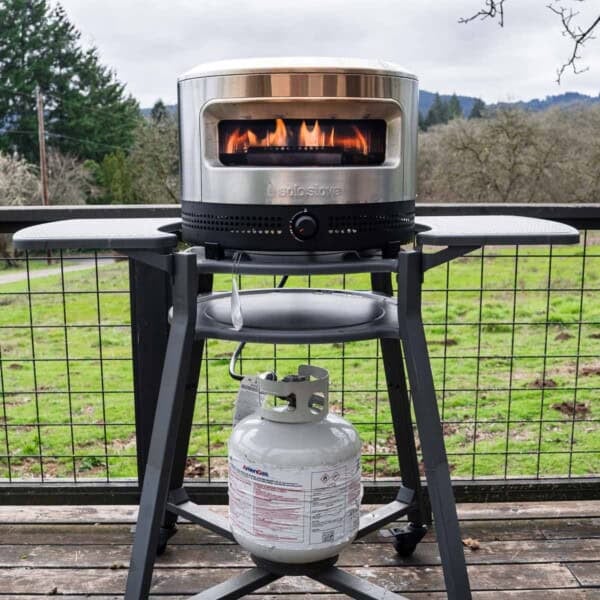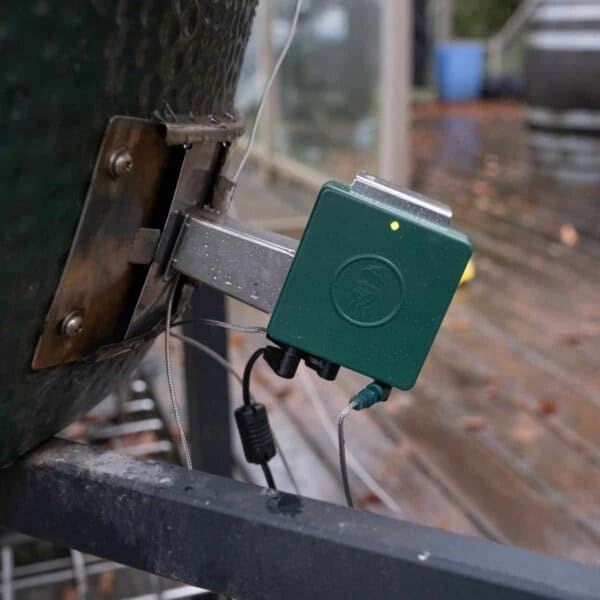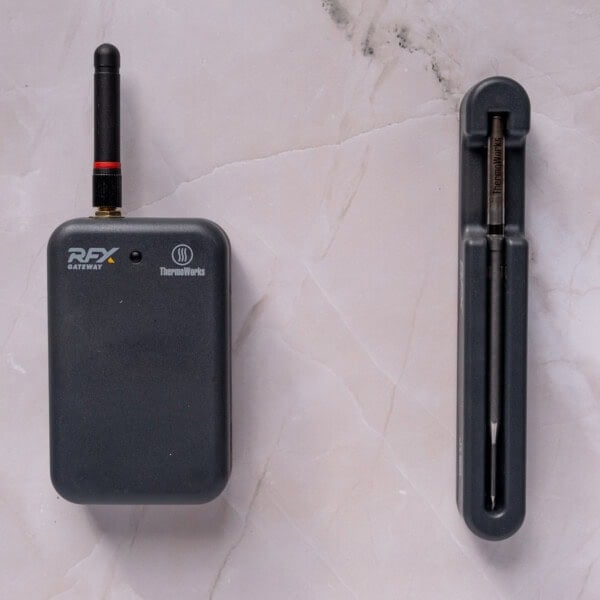The Best Pizza Stone For The Grill Or Oven
May 28, 2025
This post may contain affiliate links. Read more at our disclosure policy.
Ready to take your pizza game from “pretty good” to “better than delivery”? Whether you’re firing up a backyard grill or pizza oven or sliding pies into your home oven, one essential tool will get you there: a good pizza stone, also known as a baking stone.
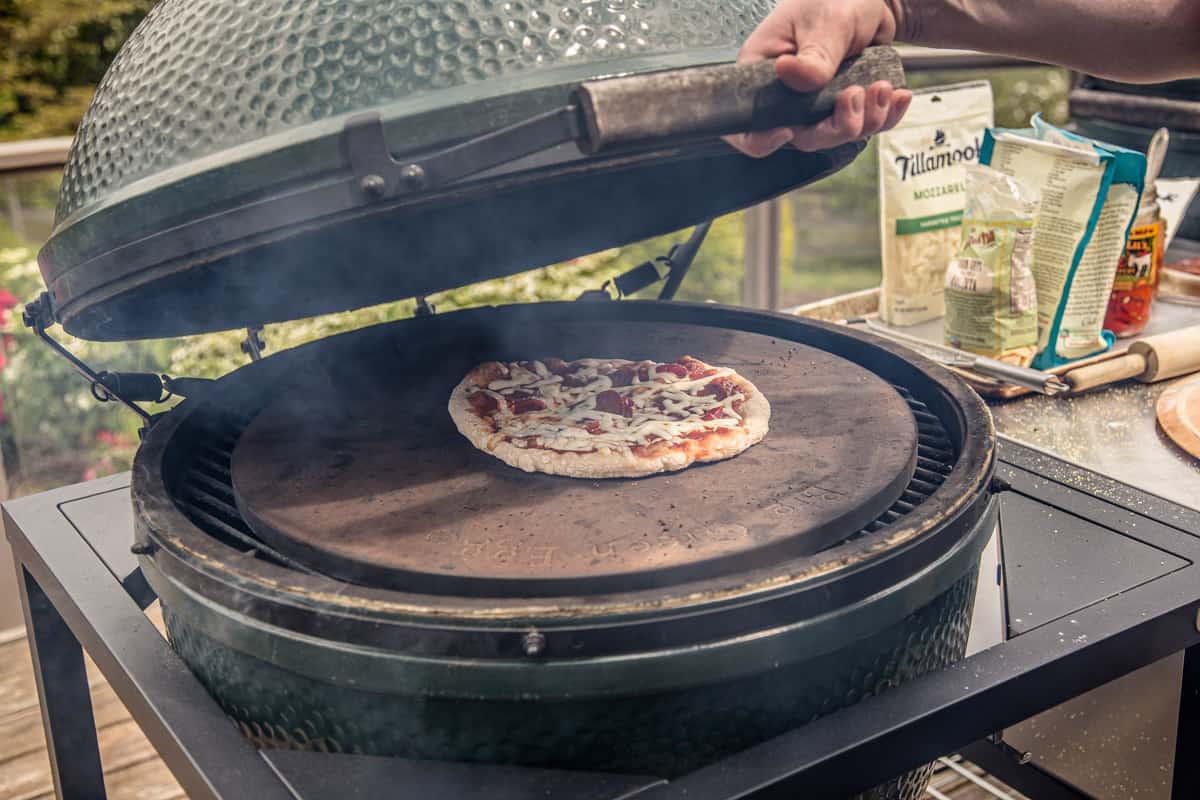
Table of Contents
- Why Cordierite Pizza Stones Are the Best
- How Does a Pizza Stone Work?
- What to Look for when buying a Pizza Stone
- Usage Tip
- Best Pizza Stones – Top Picks
- Pizza Steel Or Cast Iron?
- Pizza Stone vs. Pizza Steel
- How to Use a Pizza Stone
- How to Clean and Maintain Your Pizza Stone
- Fun Ways to Use Your Pizza Stone
- Frequently Asked Questions
- Other Important Tools
- Final Slice
When searching for the best pizza stones for the grill or best pizza stones for an oven, people often stumble into a sea of options—ceramic, clay, steel, and stone. But here’s the truth: not all stones are created equal. For durability, heat performance, and safety, cordierite stands out as the clear winner.
Let’s break down why you need one, what to look for, and how to use and care for it. It’s going to be a good choice for your next pizza recipe because one of the most important steps in great pizza is cooking the pizza on the stone at the proper temperature.
Pin this now to remember it later
Pin ItWhy Cordierite Pizza Stones Are the Best
Cordierite, which is in the ceramic family, is a naturally occurring mineral that’s been engineered to handle extreme temperatures. When used to make pizza stones, it can be used to bake pizzas, loaves of bread, or anything you would typically bake in an oven.
They offer:
- High thermal resistance (think 1,000°F+)
- Durability under direct heat or open flame
- No cracking or breaking with sudden temperature changes
- Excellent density of pizza stone for even heat distribution and moisture absorption
- No rust which can happen with steel or cast iron
In other words, it’s tough, reliable, and made for real backyard or oven use. Ceramic and clay stones? They’re fragile, more likely to crack, and better left in the past.
How Does a Pizza Stone Work?
Think of a pizza stone like a hot, crispy magic carpet for your dough. When preheated properly, the stone stores a ton of heat—thanks to the high density of pizza stone material like cordierite—and that heat transfer goes directly to the bottom of your pizza dough the moment it hits the surface.
Here’s what’s happening (no science degree needed):
- Even Heat: Your oven or grill may have hot spots, but a good pizza stone evens out that heat so your crust cooks uniformly from edge to center.
- Moisture Absorption: The stone’s porous surface pulls moisture away from the dough, giving you a crispy, chewy pizza crust instead of a soggy middle.
- Consistent Results: Because of the density of pizza stone, it holds on to heat even when you open the oven or pop in a cold dough—keeping your cooking temperature steady.
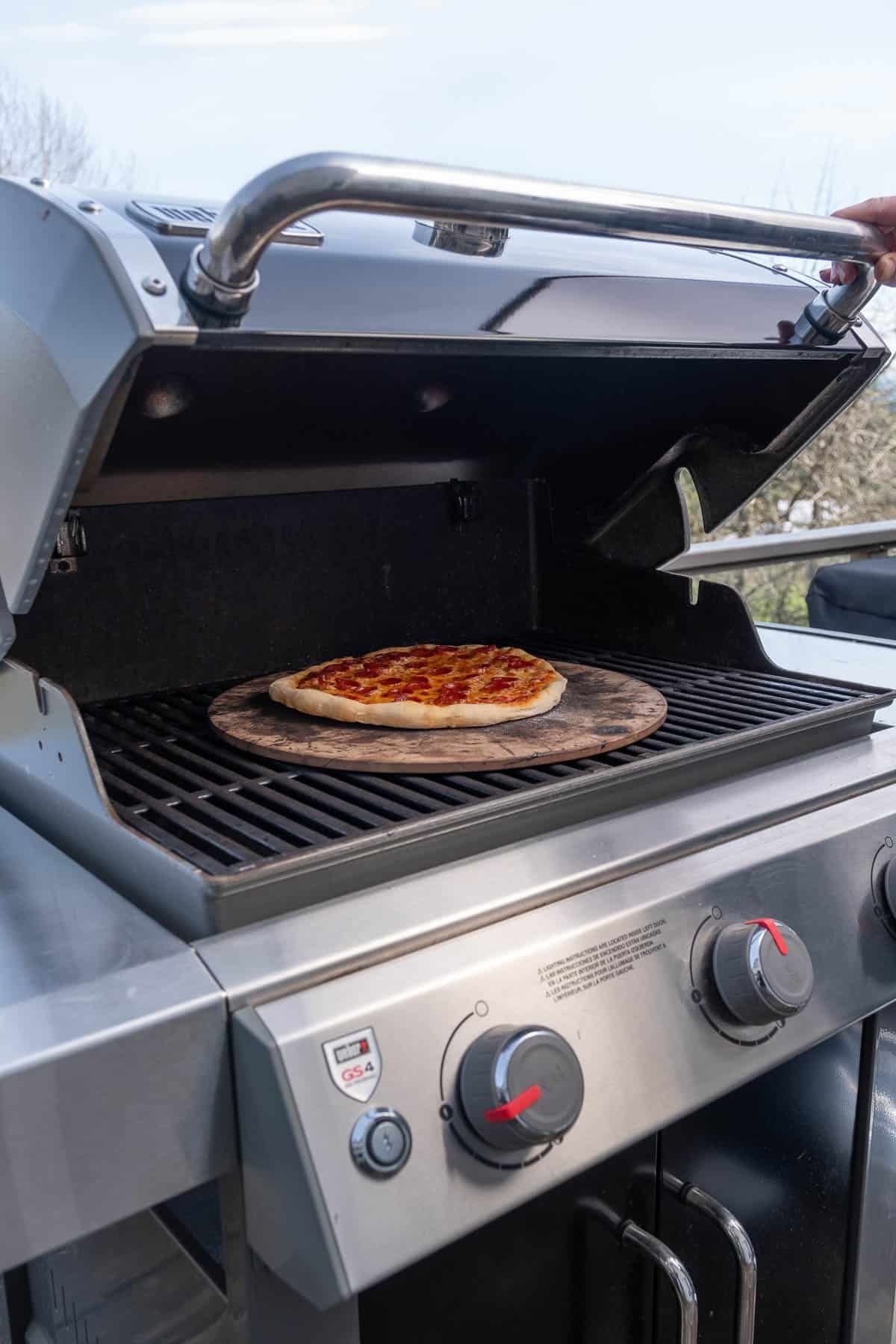
So instead of baking your pizza on a metal sheet that fluctuates in temperature, you’re baking on a hot, solid surface designed to give you those pizzeria-quality results at home.
Your pizza stone should be at the proper temperature for your style of pizza. For an oven or grill that’s 500 – 500 degrees Fahrenheit. For a pizza oven like a Gozney Dome or Neapolitan Margherita Pizza that’s 700 degrees F. So your stone needs to handle the heat.
What to Look for when buying a Pizza Stone
1. Temperature Rating
Always check the stone’s max temperature. For oven use, it should easily withstand temperatures of 700°F, while grill-ready stones should be rated for at least 1,000°F. The density of the pizza stone in cordierite means it heats evenly and holds that heat, so your crust gets golden and crisp, not soggy.
2. Thickness and Weight
A thicker stone means a higher density of pizza stone, and that translates to more heat retention. Aim for stones at least 0.6″ to 1″ thick. They take a little longer to preheat but pay off in baking performance and crust quality.
3. Shape and Size
Match your stone to your cooking setup:
- Round: Classic pizza shape, perfect for circular grills or pizza ovens.
- Rectangular Pizza Stones: Great for ovens or large grills; more space for bread, flatbreads, and multiple pies.
Just make sure there’s 1″ of airflow around the stone inside your oven or grill.
4. Pizza Ovens
If you are using a pizza oven, like a Solo Stove Pi or an Alfa Forni, they have the pizza stones built into their design. Typically, they are made of cordierite.
Usage Tip
If you are grilling on a charcoal grill like a Weber, we recommend a pizza steel because the charcoal gets so hot it can crack a stone. Or if using a stone, be sure that you move the lit charcoal along each side of the grill to avoid it sitting directly underneath.
For gas grills, light the outer burners and place the pizza stone on the grate in the center.
For pizza on a pellet grill, try to get height by placing the pizza stone on an upper rack. Or read our article on how to make pizza in a pellet grill.
For kamado grills like the Big Green Egg XL use the conveggtor plate with legs up, the grill grate, and your pizza stone. Learn more in our article on how to grill pizza on a Big Green Egg.
Would you like to save this?
Best Pizza Stones – Top Picks
These are tested, durable, and perform beautifully under high heat:
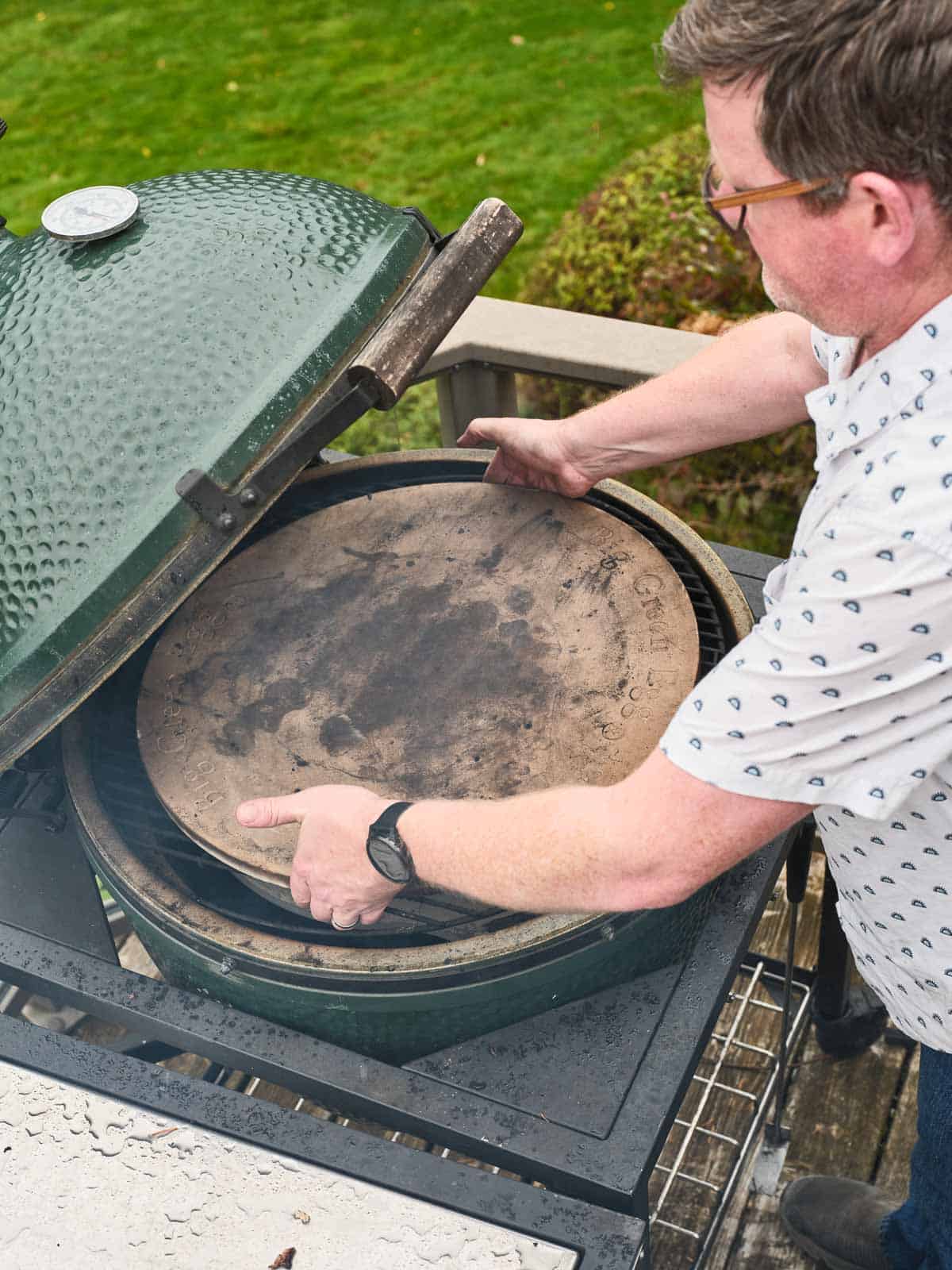
Best For Kamado Grills: Big Green Egg Pizza Stones
- Max Temp: 800°F
- Large surface area for grilling and multiple size options, comes in 12-inch, 14-inch, and 21-inch.
- Excellent density of pizza stone for crispy crusts and consistent temperature.
- 3-year limited warranty.
- Buy at a local Big Green Egg Independent dealer or from Big Green Egg online.
Best Charcoal or Gas Grill: Weber Gourmet BBQ Pizza Stone
- Max Temp: 750°F
- Perfect for grills or large ovens, also works with the Weber grill grate system.
- High-density cordierite for even, crack-free baking.
- 2-year limited warranty.
- Purchase on Amazon, Ace Hardware, or through Weber.
Best For High Heat For Oven and Grill: KitchenStar 16-inch
- Max Temp: 1,800°F
- Great to use in oven and grills for round pizza ovens or kamado-style grills.
- Balanced size and weight with reliable 5/8th inch thickness.
- Multiple size options from 12-inches to 16.
- Purchase the KitchenStar Stone through Amazon directly.
Pizza Steel Or Cast Iron?
You can also purchase a pizza steel or cast cast-iron pizza accessory. We only use steels when we are using a grill. Pizza steel can get hot fast and can swing in temperature. They can also rust easily with such large heat and cool swings.
Cast iron pizza pans are great for a home oven, but we find they are best for specialty pizzas like a Deep Dish or a Detroit-style pizza. The pizza stone is still more versatile.
Pizza Stone vs. Pizza Steel
You might be wondering, “Should I buy a pizza steel instead?” It depends.
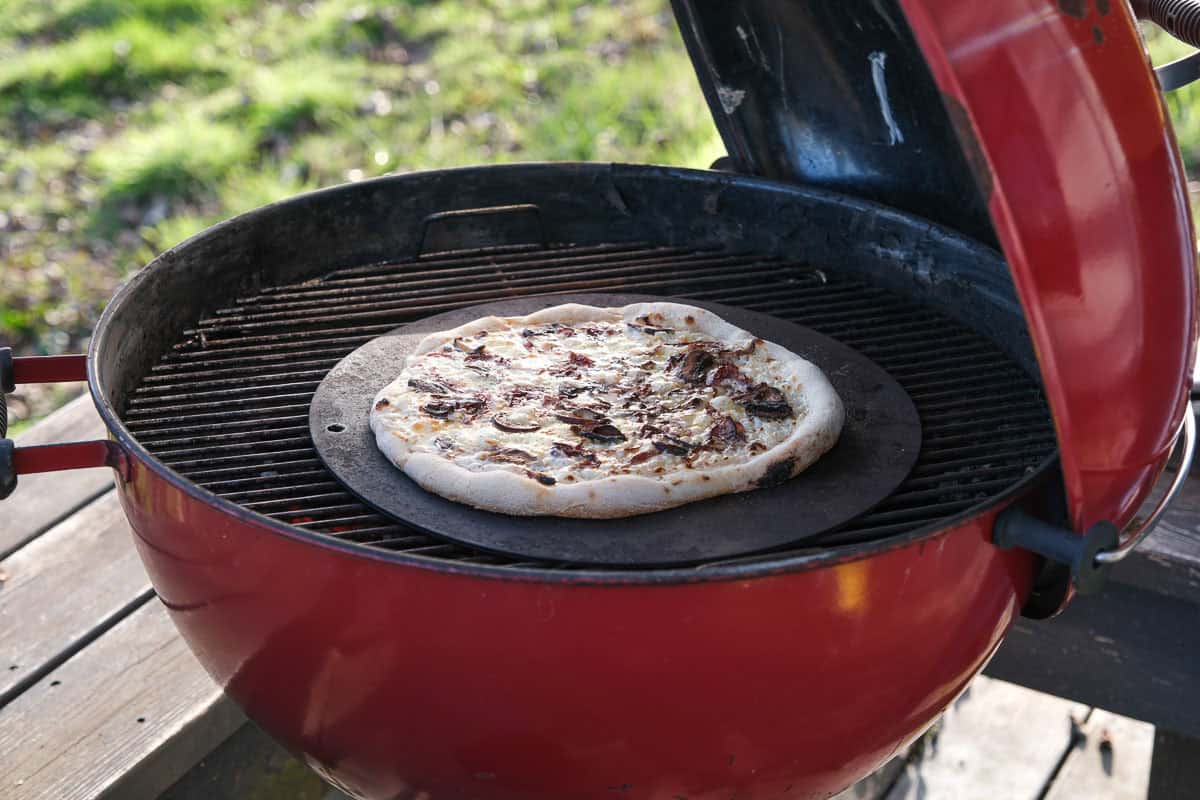
| Feature | Pizza Stone | Pizza Steel |
| Material | Cordierite, or similar material | Steel |
| Density | High thermal mass. | Extremely dense, faster heat up. |
| Crust Texture | Crisp with light char. | Deep browning, fast cooking. |
| Grill Safe | Yes. | Yes, but typically for kettle charcoal grills. |
| Durability | Excellent with care. | Subject to rusting. |
Verdict: Use a cordierite stone for grilling and oven use. Pizza steels are great for ovens only and produce more browning—but they don’t deliver the same dry, crisp crust texture unless you’re baking at very high heat.
How to Use a Pizza Stone
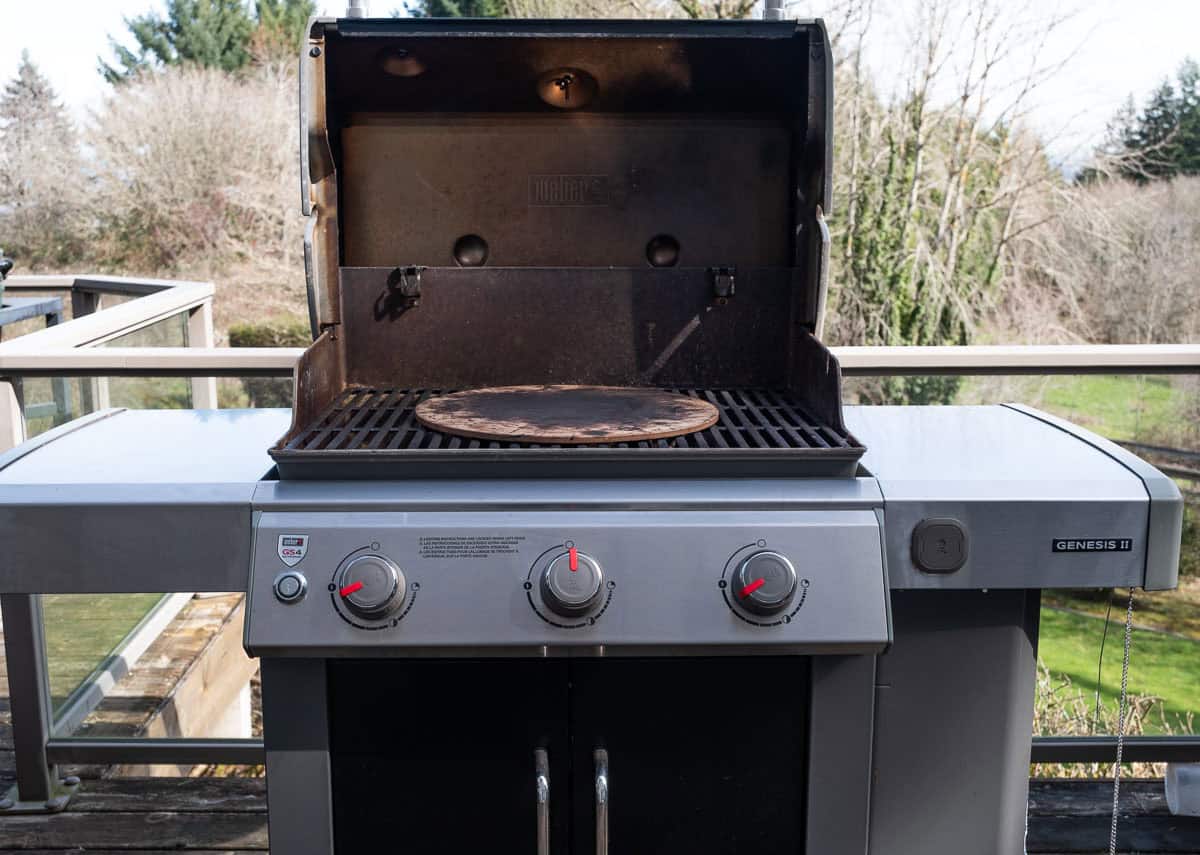
Here’s how to make the most of your pizza stone:
- Preheat it for 30–45 minutes (in the oven or on the grill) before baking any food on it. Use the center rack if using it in a home kitchen oven.
- Never place a cold stone in a hot grill—preheat gradually to avoid thermal shock (even though cordierite is great at handling it).
- Launch your pizza using a pizza peel and dust with semolina flour versus corn meal. Corn meal is larger in grit size and can burn, but semolina flour won’t and still allows the pizza crust to slide right off.
- Bake pizza direct on the pizza stone for the recommended time.
How to Clean and Maintain Your Pizza Stone
Pizza stones are low-maintenance, but here’s how to keep it in shape:
- No soap! Stones are porous and can absorb soap. If you have a light cleaning, use a damp cloth.
- Scrape off stubborn stuck-on food with a brush or metal spatula once cool.
- For deep cleans, bake it at 500°F for an hour to burn off residue. For pizza ovens run it at 800 degrees for up to 10 minutes.
- Store flat and dry inside.
And don’t worry about stains—they’re proof of a well-loved, well-used pizza tool.
Fun Ways to Use Your Pizza Stone
Let’s be honest—you’ll want to use this thing for more than just pizza:
- Grill garlic naan, garlic knots, or flatbreads
- Reheat leftover pizza (better than a microwave, 1000x better)
- Bake crispy cookies, cast-iron-style
- Impress guests with dessert pizza (Nutella + marshmallow = win) from our cookbook Fire + Wine: Backyard Pizza.
Basically, if it fits, you can crisp it.
Frequently Asked Questions
Yes! That’s one of the biggest benefits of a cordierite stone. It’s built to handle extreme temperatures—typically up to 1,400°F—making it perfect for both grills and ovens.
Its high durability and the density of pizza stone material help it absorb and retain heat evenly, ensuring your pizza cooks properly no matter the heat source.
The density of pizza stone affects how well it absorbs and holds heat. A denser stone—like one made from cordierite—can preheat to a high temperature and maintain even heat across the surface.
This results in a perfectly crisp pizza crust and prevents hot spots or undercooked dough. Low-density materials (like thin ceramic or clay) don’t perform as reliably and are more prone to cracking or uneven cooking.
The best way to avoid cracking is to preheat the stone gradually. Always place the cordierite stone in a cold oven or grill and let it warm up as the temperature rises.
Even though cordierite is highly resistant to thermal shock, it’s a good practice for longevity. Also, avoid getting it wet when it’s hot—moisture plus rapid temperature changes can be risky.
Other Important Tools
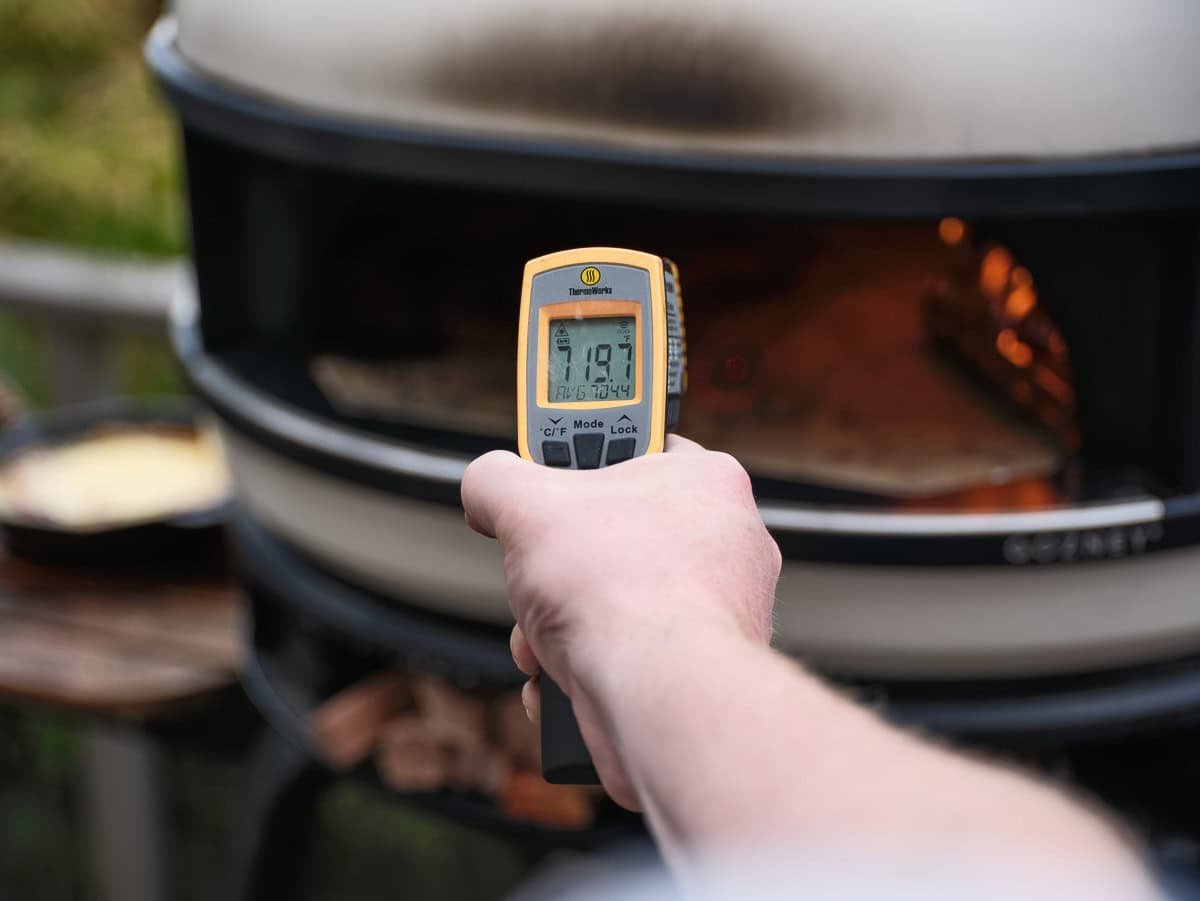
If you are making pizza at home or in your backyard, there are other key tools you should own. An IR Thermometer, like what Thermoworks makes, it’s key for measuring the temperature of your pizza stone.
A bench scraper makes prep easy. We love a Steelport American-made scraper. Another key prep tool is a good digital scale. It is (in our opinion) necessary for making the best pizza dough or bread.
Explore all of the best pizza tools in one place.
Final Slice
When it comes to pizza tools, few are as satisfying (and as reliable) as a high-quality cordierite pizza stone. Whether you’re searching for the best pizza stones for grill setups or indoor oven baking, look no further than cordierite for its toughness, temperature tolerance, and superior density of pizza stone.
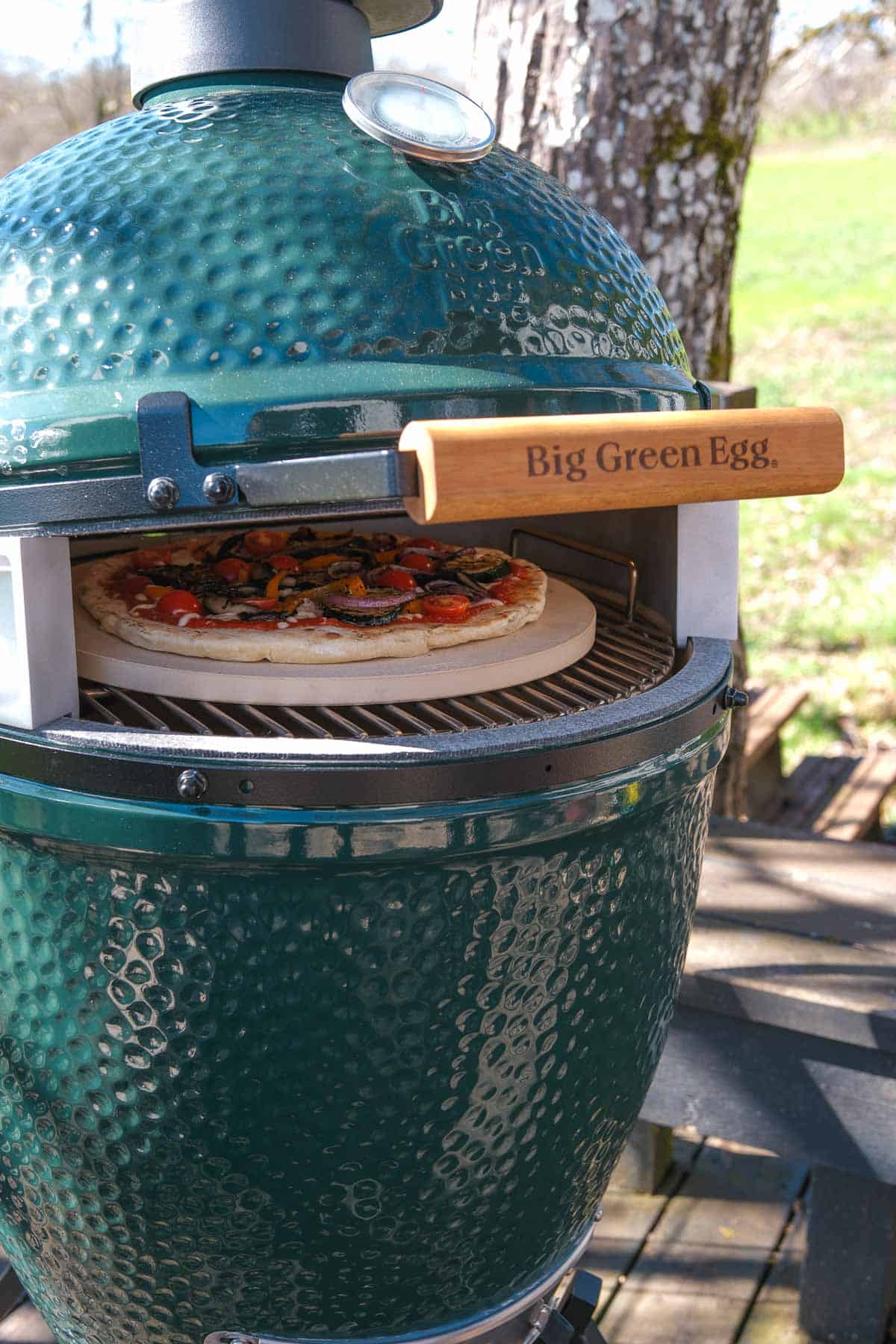
With the right pizza stone, the right dough, and the right amount of heat, you’re not just making a pizza, you’re making a memory. Now, grab a pizza stone that’s best for you and check out our pizza recipes for inspiration.




